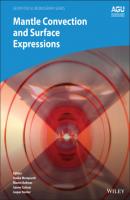Mantle Convection and Surface Expressions. Группа авторов
Чтение книги онлайн.

Читать онлайн книгу Mantle Convection and Surface Expressions - Группа авторов страница 26
Название: Mantle Convection and Surface Expressions
Автор: Группа авторов
Издательство: John Wiley & Sons Limited
Жанр: Физика
isbn: 9781119528593
isbn:
where α is a parameter that describes the contribution of grain boundary sliding, D is the diffusion coefficient, σ is stress, Ω is atomic volume, h is grain size, m is 2–3, R is the gas constant (8.314510 J/mol∙K), and T is temperature. Grain size dependence comes about because efficiency of diffusion is strongly dependent on length scale (D ≈ l2/t) and thus diffusion creep is efficient only over short lengths, i.e., small grain sizes. Diffusion coefficients have an Arrhenius type relationship with temperature (Arrhenius, 1889; van’t Hoff, 1884). The effect of pressure can also be included, leading to a temperature and pressure dependence of the diffusion coefficient, which is given by
where D0 is termed the frequency factor, Ea is activation energy and Va is the activation volume (e.g., Poirier, 1985). Thus, high temperature increases the efficiency of diffusion creep while pressure lowers efficacy. Thus, viscosity of a mineral will generally decrease with temperature and increase with pressure.
On the other end of the spectrum, at high stress and low temperatures, plasticity occurs by dislocation glide. Dislocations accommodate strain through the propagation of linear defects through a crystal. Dislocations occur on a slip system that is characterized by a plane (hkl) and a direction <uvw>. Shearing along the slip plane in the slip direction results in an offset in the crystal lattice thus accommodating shear strain. Resistance to glide is controlled by the Peierls stress (Nabarro, 1947; Peierls, 1940). For a monoatomic lattice, the Peierls stress (σp) is given by
where G is the shear modulus, w is a term that depends on the dislocation character (screw vs. edge), dhkl is the lattice spacing of the glide plane and
At stress conditions, intermediate to dislocation glide and diffusion creep, deformation is dominated by dislocation creep, i.e., glide accommodated by climb via diffusion. When dislocation glide alone is active, dislocations can interact and encounter obstacles to dislocation motion, which results in hardening. When stresses are low (typically due to high temperature and/or slow strain rates), dislocations can climb (diffuse) out of plane to bypass obstacles. Depending on ease of climb, various forms of constitutive laws can be written (Weertman, 1970; Weertman & Weertman, 1975). These lead to a nonlinear stress–strain rate relationship where
Frequently a general constitutive equation is used that can capture both diffusion and dislocation creep (Hirth & Kohlstedt, 2003):
where A is an empirically determined pre‐exponential factor. For diffusion creep, n is 1 and m is 2–3, and for dislocation creep n is typically 3–5 and m = 0.
While it is relatively straightforward to determine deformation mechanisms in the laboratory, it is much harder to determine operative mechanisms in the deep Earth. For crustal and upper mantle rocks, microstructural signatures of deformation can be observed and provide constraints on active deformation mechanisms (e.g., Knipe, 1989; Park & Jung, 2017; Passchier & Trouw, 2005). However, for the lower mantle natural samples of sufficient size to study and determine deformation mechanisms are not available, and deformation mechanisms must be inferred indirectly. Seismic observations are one of the few methods to image the Earth’s deep interior, and seismic anisotropy can provide clues to deformation mechanisms in the deep Earth. Seismic anisotropy is generally attributed to texture development due to plastic deformation by dislocation creep. It is generally assumed that if there is no anisotropy, diffusion creep is operative, as in most case diffusion creep does not induce texture. Conversely, the general assumption is that if seismic anisotropy is observed, dislocation creep is likely (see Karato (2010) for a discussion of potential deformation mechanism in the mantle).
Note that a few cases have been observed where texture does develop in minerals deformed in diffusion creep, as defined by Newtonian rheology (n = 1). These are generally samples that have been deformed near the transition between diffusion creep and dislocation creep (e.g., Barreiro et al., 2007), unusual cases in the presence of fluid/melt (Bons & den Brok, 2000), or due to strongly anisotropic grain shapes (Miyazaki et al., 2013; Yoshizawa et al., 2004). One should also recognize that deformation by diffusion and dislocations are competing processes and that both diffusion creep and dislocation creep can operate simultaneously in the same sample.
In the lower mantle, seismic anisotropy is observed at the top of the lower mantle near subducting slabs (Ferreira et al., 2019; Lynner & Long, 2015; Mohiuddin et al., 2015; Wookey et al., 2002) and also at the base of the mantle in the D” region (for recent summaries of D” anisotropy, see Creasy et al., 2019 and Romanowicz & Wenk, 2017). In contrast to these regions, the bulk of the mantle appears to be seismically isotropic. This has led to the suggestion that the bulk of the mantle deforms by diffusion creep (Karato et al., 1995), whereas regions of high strain near subducting slabs and at boundary layers such as near the CMB undergo deformation by dislocation creep (McNamara et al., 2002). However, others have suggested that isotropy might be due to patterns of anisotropy for Brg and Fp that cancel each other leading to an isotropic aggregate (Wenk, Speziale, et al., 2006). In any case, it appears that dislocation creep is active in at least some regions of the lower mantle, but it might also be likely that the mantle is close to the transition between diffusion creep and dislocation creep. As such, strain rate gradients in the mantle may result in transitions between diffusion‐dominated and dislocation‐dominated regimes.
2.3 METHODS: EXPERIMENTAL DEFORMATION OF LOWER MANTLE MINERALS
Deformation СКАЧАТЬ